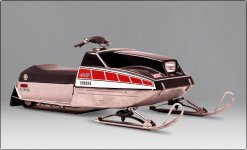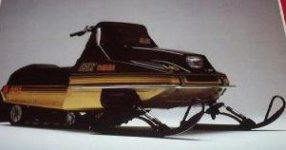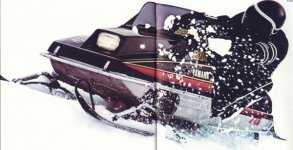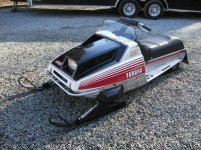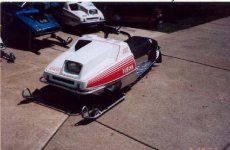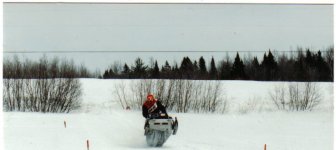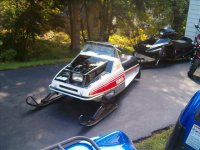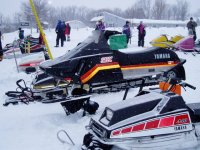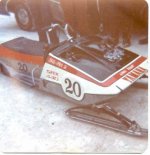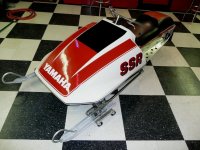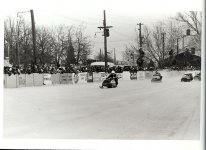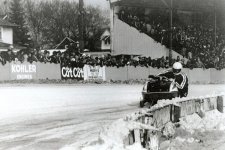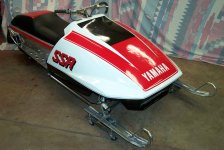SRX500_129
New member
The history in my words:
SRX is a true legend!
S = Sport
R = Racing
X = Xperimental
motor code RT = Racetuned
L/C = Liqued cooled:
1976 to 1977: RX
1978 til 1980: RT439 L/C standard bore: 68,5 mm
1981 (EUR): RT439 L/C standard bore: 68,5 mm
1981 (US/CAN): RT437 L/C standard bore: 66 mm
1982: RT499 L/C standard bore: 70,5mm
Power:
1974: 115 hp (new info)
1976: 8A8 65 hk on the 340 engine
1976: 8A7 91 hk ved 9300 rpm. on the 440 engine
1977: 8F2 100 hk with less volume in the heads (8F2 type).
1978: 8H1 / 8G9 95 hp (droped to 85 hp) the heads made a lot of problems and after a while the customers got the new 8J0 heads. then the engine lost a few hp, but it was more realible. the sylinders (8G9) had a lot of changes to, but didnt make any problems.
1979: 8JO 82 hk at 9000 rpm. it is the same engine as in the 1978, BUT THIS TIME WITH THE 8J0 heads as standard on the 8G9 sylinders..
1980 8K2 (USA/CAN), 8K6 (Europa): 80 hk.
1981 8K6 (EUROPE): 80 hk
1981 8M6: 88 hk ved 9000 rpm.
1982 8R9: 98 hk ved 8800rpm. 499ccm
Volum in Heads:
8A8 76 mod: 15 cc
8A7 76 mod: 18,5 cc
8F2 77 mod: 18,5 cc
8H1 1978: 20,5 cc
8J0 78,79 og 80 mod: 21,5 cc
8M6 81 mod: 17,3
8R9 82 mod: 18,5
Carburators (VM = round slide, B = butterfly (spjeld)):
1974 no info at the time
1976 2 x Mikuni VM40
1977 2 x Mikuni VM40
1978 2 x Mikuni VM36
1979 2 x Mikuni VM36
1980 2 x Mikuni B40-38
1981 2 x Mikuni B40-38 on the Europe version
1981 2 x Mikuni B42-40 on the SRX 440E
1982 2 x Mikuni B44-42
1998 til 2002 3 x Mikuni TM33
Vekt:
1976 til 77: 168 kg
1978 til 1980: 180kg
1981: 215 kg
1982: 225 kg (this info comes from my own sled)
1998 til 2000: 234 kg
2001 og 2002: 236 kg
here is some history:
SRX was from the beginning first ment for racing and competitions, but after a few years it became a product for normal customers. SRX is Yamahas first L/C snowmobile.
Yamaha SRX years:
in 1974 Yamaha factory-raced with a few SRX 440 sno-pro models this is a model only ment to this. This sled was equiped with a Watercooled 2 syl 440 engine. Every singel one of this sleds are/was unik and had different specs. I have bbeen told that there was only 6 of them and every singel one is destruted.
Great info by RJH (membername):
In 1975 – they made a limited model that fit all the GPX parts but was much lighter and looked better – the chassis was very thin aluminium. It was most likely the same engine as the 73 model.
The 440 was about 100 HP very narrow power band. We never had it on the dyno …… but the late Bud Lees Koehler’s were dynoed at over a 100 HP by the factory in Toronto.
We had slightly better speed - so must have been there also. The 340 would almost do 100 mph as well on an ice ½ mile so it was pumping out some HP. The rpm band was about 3 so it was tricky to clutch.
This was watercooled as well – but had the basic port configuration as the GYT kits – not polished at all. All the parts that moved were very light on the engine and sled. Ignition was TZ. The pipe was special - paper thin.
This sled was called the SRX. The same sled was built in 76 (to look like the stock sled) – but the engine used the standard barrels – factory built.
They used circle M – we went thru about 8 sets a season…...on each sled. The symptom would be like trying to tune a VM with no high speed air jet. You can still get it go fast – but it lost that little extra.
in 1976 introduced Yamaha the SRX model, a 340 and the legendary 440 with 439 cc RT engine.. This was the first model for Yamaha with Liqued cooled engine. Yamaha SRX var den første serieproduserte Yamaha skuteren som var vannavkjølt. In cometitions it became a big winner. None of the SRX was sold for normal use, this was a race-sled and it was not usable to anything else.
http://www.totallyamaha.net/forums/attachment.php?attachmentid=31613&stc=1
1977 came SRX440A with a modified chassis fwith wider steering, it was easy to see those "bulked" sides over the ski's. a new boggie and a bit different decalset. the hood was white with red stripes in the sides SRX440A is the most powerfull SRX and lightest of them all.
http://www.totallyamaha.net/forums/attachment.php?attachmentid=31614&stc=1
1978 kom SRX440B had a new exhaustsystem, and more mods on the chassis. there was a few parts on the sled that yamaha changed out: new and more complete intrumentals, and a windscreen for the first time, the hood was black on the top with red stripes. the sled came in 2 diferent styles, one was ment for israce/race.

1979 kom SRX440C, with some news: better frontbumper, new decals, lower compression with a few less horsepower, a different topend with more volume, and the sylindres was modified. All this changes in the engine was because of all the problems the 77 and 78 gave Yamaha. Yamaha ment that there was no loss in power because of this modds, but the story tell a diferent truth! . The Color for this year was black: Jet-Black!
http://www.totallyamaha.net/forums/attachment.php?attachmentid=31616&stc=1
1980 kom SRX440D, with some few changes, the whole chassis was Goldeloxed). the customers could buy the sled with to diferent type of boggie, one more lower than the other.. SRX440D engine was weak, and thhe reason was because Yamaha wanted it to hold (realeble (hell, whats that word?? sorry, i am from Norway and doing my best)). Yamaha put some new carburators this year, and with brand new intake manifolds that gave the powerloss down to 80 hp.

1981 come SRX440E as a brand new sled, with new technic all over it. the engine was allso brand new, with new carbs and more. this was a sled that was really powerfull over 6000 rpm, but not under. that became a problem that season, so Yamaha had to do something about it. The engine was therefor not good for this new type of sled, the weight took away its power under 6000 rpm. The new TSS was not new for Yamaha, they first use it on the SR-V 540 aircooled sled.

1981 for Europe: this was the same sled as the 180 440D, but in silvereloxed chassis, and with black hood.

in 1982 Yamaha wanted to give the SRX more power with this new SRX 500F model, but something went wrong. The engine had some new carbs, this carbs was not easy to tune in. it was not the only problem, the sylinders was heavily modified and gave a lot of power, not only in the top end of the rpm scale. it was a really fast sled with a engine that gave a hell of a ride if the engine was tuned good, and it also gave the true hell if not.. Yamaha produced a line of 2500 sleds, but only 150 of them ever left the fabric. 100 of them ended in the US/Can marked, but non left out to customers. In Europe there was some Customers that get it out for use. For us who live to day, this sled is a true ghost! if you read the book of Yamaha's 40th's history, you will find out that Yamaha dont want to admit the eksistens of the SRX 500. I wonder why???
1981 and 1982 SRX blunders killed the story of this legend.. it stoped with a true Ghost that i happend to have one of! So I know that its a piece left in the yamaha story that's not yet been told by the makers..
the rest of the SRX sleds has not the RT (Race tuned) engine, so i let them in peace
thank you for reading this, if someon want to translate this to bether english, pleace do so
best regards
O-e from Norway..
Pictures belove shows the 1976, 1977, 1978, 1979 and 1980 SRX 440 in correct order .
SRX is a true legend!
S = Sport
R = Racing
X = Xperimental
motor code RT = Racetuned
L/C = Liqued cooled:
1976 to 1977: RX
1978 til 1980: RT439 L/C standard bore: 68,5 mm
1981 (EUR): RT439 L/C standard bore: 68,5 mm
1981 (US/CAN): RT437 L/C standard bore: 66 mm
1982: RT499 L/C standard bore: 70,5mm
Power:
1974: 115 hp (new info)
1976: 8A8 65 hk on the 340 engine
1976: 8A7 91 hk ved 9300 rpm. on the 440 engine
1977: 8F2 100 hk with less volume in the heads (8F2 type).
1978: 8H1 / 8G9 95 hp (droped to 85 hp) the heads made a lot of problems and after a while the customers got the new 8J0 heads. then the engine lost a few hp, but it was more realible. the sylinders (8G9) had a lot of changes to, but didnt make any problems.
1979: 8JO 82 hk at 9000 rpm. it is the same engine as in the 1978, BUT THIS TIME WITH THE 8J0 heads as standard on the 8G9 sylinders..
1980 8K2 (USA/CAN), 8K6 (Europa): 80 hk.
1981 8K6 (EUROPE): 80 hk
1981 8M6: 88 hk ved 9000 rpm.
1982 8R9: 98 hk ved 8800rpm. 499ccm
Volum in Heads:
8A8 76 mod: 15 cc
8A7 76 mod: 18,5 cc
8F2 77 mod: 18,5 cc
8H1 1978: 20,5 cc
8J0 78,79 og 80 mod: 21,5 cc
8M6 81 mod: 17,3
8R9 82 mod: 18,5
Carburators (VM = round slide, B = butterfly (spjeld)):
1974 no info at the time
1976 2 x Mikuni VM40
1977 2 x Mikuni VM40
1978 2 x Mikuni VM36
1979 2 x Mikuni VM36
1980 2 x Mikuni B40-38
1981 2 x Mikuni B40-38 on the Europe version
1981 2 x Mikuni B42-40 on the SRX 440E
1982 2 x Mikuni B44-42
1998 til 2002 3 x Mikuni TM33
Vekt:
1976 til 77: 168 kg
1978 til 1980: 180kg
1981: 215 kg
1982: 225 kg (this info comes from my own sled)
1998 til 2000: 234 kg
2001 og 2002: 236 kg
here is some history:
SRX was from the beginning first ment for racing and competitions, but after a few years it became a product for normal customers. SRX is Yamahas first L/C snowmobile.
Yamaha SRX years:
in 1974 Yamaha factory-raced with a few SRX 440 sno-pro models this is a model only ment to this. This sled was equiped with a Watercooled 2 syl 440 engine. Every singel one of this sleds are/was unik and had different specs. I have bbeen told that there was only 6 of them and every singel one is destruted.
Great info by RJH (membername):
In 1975 – they made a limited model that fit all the GPX parts but was much lighter and looked better – the chassis was very thin aluminium. It was most likely the same engine as the 73 model.
The 440 was about 100 HP very narrow power band. We never had it on the dyno …… but the late Bud Lees Koehler’s were dynoed at over a 100 HP by the factory in Toronto.
We had slightly better speed - so must have been there also. The 340 would almost do 100 mph as well on an ice ½ mile so it was pumping out some HP. The rpm band was about 3 so it was tricky to clutch.
This was watercooled as well – but had the basic port configuration as the GYT kits – not polished at all. All the parts that moved were very light on the engine and sled. Ignition was TZ. The pipe was special - paper thin.
This sled was called the SRX. The same sled was built in 76 (to look like the stock sled) – but the engine used the standard barrels – factory built.
They used circle M – we went thru about 8 sets a season…...on each sled. The symptom would be like trying to tune a VM with no high speed air jet. You can still get it go fast – but it lost that little extra.
in 1976 introduced Yamaha the SRX model, a 340 and the legendary 440 with 439 cc RT engine.. This was the first model for Yamaha with Liqued cooled engine. Yamaha SRX var den første serieproduserte Yamaha skuteren som var vannavkjølt. In cometitions it became a big winner. None of the SRX was sold for normal use, this was a race-sled and it was not usable to anything else.
http://www.totallyamaha.net/forums/attachment.php?attachmentid=31613&stc=1
1977 came SRX440A with a modified chassis fwith wider steering, it was easy to see those "bulked" sides over the ski's. a new boggie and a bit different decalset. the hood was white with red stripes in the sides SRX440A is the most powerfull SRX and lightest of them all.
http://www.totallyamaha.net/forums/attachment.php?attachmentid=31614&stc=1
1978 kom SRX440B had a new exhaustsystem, and more mods on the chassis. there was a few parts on the sled that yamaha changed out: new and more complete intrumentals, and a windscreen for the first time, the hood was black on the top with red stripes. the sled came in 2 diferent styles, one was ment for israce/race.

1979 kom SRX440C, with some news: better frontbumper, new decals, lower compression with a few less horsepower, a different topend with more volume, and the sylindres was modified. All this changes in the engine was because of all the problems the 77 and 78 gave Yamaha. Yamaha ment that there was no loss in power because of this modds, but the story tell a diferent truth! . The Color for this year was black: Jet-Black!
http://www.totallyamaha.net/forums/attachment.php?attachmentid=31616&stc=1
1980 kom SRX440D, with some few changes, the whole chassis was Goldeloxed). the customers could buy the sled with to diferent type of boggie, one more lower than the other.. SRX440D engine was weak, and thhe reason was because Yamaha wanted it to hold (realeble (hell, whats that word?? sorry, i am from Norway and doing my best)). Yamaha put some new carburators this year, and with brand new intake manifolds that gave the powerloss down to 80 hp.

1981 come SRX440E as a brand new sled, with new technic all over it. the engine was allso brand new, with new carbs and more. this was a sled that was really powerfull over 6000 rpm, but not under. that became a problem that season, so Yamaha had to do something about it. The engine was therefor not good for this new type of sled, the weight took away its power under 6000 rpm. The new TSS was not new for Yamaha, they first use it on the SR-V 540 aircooled sled.

1981 for Europe: this was the same sled as the 180 440D, but in silvereloxed chassis, and with black hood.

in 1982 Yamaha wanted to give the SRX more power with this new SRX 500F model, but something went wrong. The engine had some new carbs, this carbs was not easy to tune in. it was not the only problem, the sylinders was heavily modified and gave a lot of power, not only in the top end of the rpm scale. it was a really fast sled with a engine that gave a hell of a ride if the engine was tuned good, and it also gave the true hell if not.. Yamaha produced a line of 2500 sleds, but only 150 of them ever left the fabric. 100 of them ended in the US/Can marked, but non left out to customers. In Europe there was some Customers that get it out for use. For us who live to day, this sled is a true ghost! if you read the book of Yamaha's 40th's history, you will find out that Yamaha dont want to admit the eksistens of the SRX 500. I wonder why???
1981 and 1982 SRX blunders killed the story of this legend.. it stoped with a true Ghost that i happend to have one of! So I know that its a piece left in the yamaha story that's not yet been told by the makers..
the rest of the SRX sleds has not the RT (Race tuned) engine, so i let them in peace

thank you for reading this, if someon want to translate this to bether english, pleace do so
best regards
O-e from Norway..
Pictures belove shows the 1976, 1977, 1978, 1979 and 1980 SRX 440 in correct order .
Attachments
Last edited:
Undertaker13
New member
Trying to get my 78 running then after this season, going in for resto
YAMMIEGOD3:16
Active member
Combustion Chamber Size
76 SRX WAS 15 cc (340)
76 SRX WAS 18.5 cc (440 )
77 SRX WAS 18.5 cc
78 SRX WAS 20.5 cc
79 SRX WAS 21.5 cc
80 SRX WAS 21.5 cc
81 SRX WAS 17.3 cc
3:16 (yammie tony)
76 SRX WAS 15 cc (340)
76 SRX WAS 18.5 cc (440 )
77 SRX WAS 18.5 cc
78 SRX WAS 20.5 cc
79 SRX WAS 21.5 cc
80 SRX WAS 21.5 cc
81 SRX WAS 17.3 cc
3:16 (yammie tony)
Last edited:
SRX500_129
New member
takkar så mycket  thanks
thanks
 thanks
thanksSRX 500F -82 Combustion Camber is 18.5cc (1.12cu.in)
having owened 2) 80 and 3) 81 SRX'S in my time i can appreciate reading this, thanks
SRX500_129
New member
SRX500_129
New member
i little info about the SSR440 from 1978 to 1980 .. this was not a sled that Yamaha should be proud of (of course it was a beautyful sled!).. The only good thing about this sled was the IFS system, but this was also the blunder that killed it.. Thanks to that, Yamaha goes insted for the TSS system in 1980.. maybe that was a huge mistake!?? who can tell..
Yamaha did produced a couple of hundreds of this model, but only 104 of them hit the marked.. what happend to the rest is something i dont know about.. anyway, who cares ;P
the engine is the same as in the SRX with 8J0 Carbs .. maybe it gave some more power in the top-rpm i guess, because of the exhaust-system..

Yamaha did produced a couple of hundreds of this model, but only 104 of them hit the marked.. what happend to the rest is something i dont know about.. anyway, who cares ;P
the engine is the same as in the SRX with 8J0 Carbs .. maybe it gave some more power in the top-rpm i guess, because of the exhaust-system..

Attachments
Last edited:
dynofun
New member
- Joined
- Nov 14, 2005
- Messages
- 355
Where did you get those pictures? Sweet sled. Actually the engine is VERY different from any SRX. Yamaha won a lot more races with them than people realize. Mid year they decided to stop Sno Pro and didn't do any further development or refining to them.
RJH
New member
Great info – but you missed a model.
In 1975 – they made a limited model that fit all the GPX parts but was much lighter and looked better – the chassis was very thin aluminium. It was most likely the same engine as the 73 model.
The 440 was about 100 HP very narrow power band. We never had it on the dyno …… but the late Bud Lees Koehler’s were dynoed at over a 100 HP by the factory in Toronto.
We had slightly better speed - so must have been there also. The 340 would almost do 100 mph as well on an ice ½ mile so it was pumping out some HP. The rpm band was about 3 so it was tricky to clutch.
so it was tricky to clutch.
This was watercooled as well – but had the basic port configuration as the GYT kits – not polished at all. All the parts that moved were very light on the engine and sled. Ignition was TZ. The pipe was special - paper thin.
This sled was called the SRX. The same sled was built in 76 (to look like the stock sled) – but the engine used the standard barrels – factory built.
They used circle M – we went thru about 8 sets a season…...on each sled. The symptom would be like trying to tune a VM with no high speed air jet. You can still get it go fast – but it lost that little extra.
In 1975 – they made a limited model that fit all the GPX parts but was much lighter and looked better – the chassis was very thin aluminium. It was most likely the same engine as the 73 model.
The 440 was about 100 HP very narrow power band. We never had it on the dyno …… but the late Bud Lees Koehler’s were dynoed at over a 100 HP by the factory in Toronto.
We had slightly better speed - so must have been there also. The 340 would almost do 100 mph as well on an ice ½ mile so it was pumping out some HP. The rpm band was about 3
 so it was tricky to clutch.
so it was tricky to clutch. This was watercooled as well – but had the basic port configuration as the GYT kits – not polished at all. All the parts that moved were very light on the engine and sled. Ignition was TZ. The pipe was special - paper thin.
This sled was called the SRX. The same sled was built in 76 (to look like the stock sled) – but the engine used the standard barrels – factory built.
They used circle M – we went thru about 8 sets a season…...on each sled. The symptom would be like trying to tune a VM with no high speed air jet. You can still get it go fast – but it lost that little extra.
Attachments
SRX500_129
New member
I might add that the 1976 and 1977 SRX's got RX for motor code.motor code RT = Racetuned
The 1977 model got an all aluminium chassie, including sub frame, and even lighter suspension than the1976 model. My 1977 SRX was 152kg on the scale with studded cleated track and allmost full tank.1976 til 77: 168 kg
VM40 is what Mikuni called the biggest carb in the VM series but this do not tell how big the bore is. A VM 40 carb could be anything from 40 to 44mm and even a little more to that with a custom bore. A 1977 SRX got a 42mm VM40 carb.1976 2 x Mikuni VM40
1977 2 x Mikuni VM40
SSR cylinders is 8H0 and is uniqe to the SSR, quite simular to the 1977 8F2 jugs in the casting atleast. Carbs is a VM40 housing at 42 or 44mm and crank is different to all SRX's as well. An SSR makes lots more power than a 1978 8G9 SRX.SRX500_129 said:well, the engine is the same as it was in the 1978 SRX, with some few modds on it. the parts nr is the same as well.
Last edited:
dynofun
New member
- Joined
- Nov 14, 2005
- Messages
- 355
They appear the same and are the same design but are very different. Different crank, cases, cylinders, cylinder studs and nuts, heads, pistons, rods, ignition, carbs (44mm), and pipes of course. Stock pipes didn't work. For some reason I believe Yam made a mistake. Power was at 9,000 RPM and they had to be cut to make power at 10,000 RPM.
RJH, interesting info. I have to digest that some.
RJH, interesting info. I have to digest that some.

YAMMIEGOD3:16
Active member
YAMAHA IS NOT PROUND OF THE SSR ? THIS MIGHT NOT ONLY BE THE MOST SOUGHT AFTER COLLECTABLE RACE SLED, BUT I WOULD SAY NEXT TO THE 1982 SRX 500, THE MOST DESIREABLE YAMAHA OF ALL TIME. MORE INFO. YAMAHA RAN OUT OF 8F2 ENGINES PARTS BEFORE THEY RAN OUT OF 8H0. SO LETS SAY YOU WANTED CYLINDERS FOR YOUR 77 SRX, YAMAHA SUPERSEEDED THESE PART NUMBERS TOGETHER AS A REPLACEMENT PART. NOT MUCH IN COMMON WITH A 78 SRX. 3:16 (yammie tony)
SRX500_129
New member
yamaton:
greath info man thank you !
thank you !
Yammiegod:
what you or other think of the SRX 500 and SSR 440 to day have nothing to say.. Fact is that Yamaha has not yet admited the existens of the SRX500.. it was realised in Norway f.eks.. No mather what else they say, the sled became a hit in Norway and there where a lot of them sold up here! i still remember it, and i had one my self back in 1985 to 1988. I have one to day, it was sold as new in April 1982 and with licenseplate on it 6 april 1982 ..
Snowmobiler's Race & Rally anno 1982:
The SRX of 81 and the VMAX of 82 were machines of which Yamaha wasn't't exactly proud. Rather than just ignoring the problem, Yamaha never has released the last year's VMAX, and has offered excellent terms for trading in the 81s. An interview with Tom Berkley, Assistant Product Manager- Snowmobiles, examines the situation and what was done about it.
R&R: Tom over the years there have been several different sleds that have been referred to as "Lake Rockets" the SRX being one of them. Where did this concept come from?
BERKLEY: Well, it isn't too difficult to trace back. When most of the manufacturers were involved in oval racing, they were all developing small, lightweight, very fast sleds. The fact that these sleds were close to 768 db made them very interesting machines. A few drivers converted them into trail sleds and started this thing called lake racing which actually had been going on all the time anyway.
But when oval track racing began to decline, manufactures discovered there was still quite a market for these machines as super, hot trail sleds, or lake Rockets, if you prefer.
R&R: The 1981 SRX was promoted as being lean, mean, black, and evil. How would you describe this machine?
BERKLEY: The 1981 SRX was designed for lake racing. It had a lot of horsepower for a 440, with the capability of going very fast. It wasn't unusual for us to see one in a radar gun going over 100 mph. It was a machine of very good acceleration and top speed. It had a good suspension and other features along with its radically new styling. The thing we learned form the 81 SRX is that there certainly is a demand for a high performance machine, but they should also be a good trail machine. Of the people who but this machine very few are interested in only lake racing. Most of these people are interested in general snowmobiling.
R&R: Do many people buy them as status symbols?
BERKLEY: Of course there are some who would buy them for that reason, but the demand is good for low end torque, excellent mid range performance, and smooth clutching-- so the machine can be ridden on the trails.
R&R: What were the changes made from the 81 SRX to the 82 VMAX?
BERKLEY: The primary change was to increase the displacement from 440cc to 500cc to maintain a high level of horsepower. This gave the machine more horsepower at engagement rpm and at mid- range.
R&R: Where did the problems develop which were serious enough that the 82 VMAX was never delivered to the dealers?
BERKLEY: First, we didn't think the 82 was significantly better than the 81 in terms the average customer was looking for. It didn't meet our expectations for overall trailability.
R&R: What about the rumor that carburetion was very critical and required more than normal adjustment?
BERKLEY: It wasnt just a rumor. It was true. Machines like the SRX, with radical porting and carbs to match, have a tendency to be very sensitive to carburetion. They require frequent adjustment to suit the temperature and the altitude.
R&R: What type of carb were you working with?
BERKLEY: It had a butterfly carb with many different circuits to suit various throttle and rpm settings. Its general function was O.K., but it was difficult to adjust.
R&R: Would you have been better of with a slide valve?
BERKLEY: The 83 VMAX does have a slide valve carb. And yes, it is easier to tune. But the biggest thing is the fuel requirement of the engine. No matter which carb you use, the engine has a certain fuel requirement.
R&R: It takes a lot of fuel, is that what your saying?
BERKLEY: No, not necessarily. The SRX has a rather narrow tolerance for fuel mixture. So, if you went a few sizes too rich, it was really rich. If you go a size on the lean side it seizes. That is a narrow fuel tolerance. It was an intolerant engine fuel wise. And this is a carryover from the old oval track racing days.
R&R: Through the excellent promotion on the 82 VMAX, there must have been money paid down to the dealers to reserve a sled. Wasnt it tempting to release it anyway?
BERKLEY: Yes, the demand was certainly there, and the lake racers would have been very happy with the machine. A lot of dealers did have machines committed to their customers. But for the majority of the customers we did the right thing. It was very gratifying when our customers and dealers agreed with our decision not to release the sled. We did not receive very much static at all about that decision. I think our customers and dealers (if not the snowmobile press in every case) realize the market is evolving. Sure they want good acceleration and good top speed, but they also want a good all- around snowmobile.
R&R: A total performance snowmobile?
BERKLEY: Right! A true high performance snowmobile should perform very well in many different areas. It should not only go fast, but should handle and ride well, start easily, and go in deep snow. A big part of the high performance market is in the mountains. Mountain riding requires a machine with a wide fuel tolerance to fuel mixture. It requires good low end and horsepower, smooth clutching, and the capability to go in deep snow. This was also a consideration on our decision not to release the 82 VMAX.
R&R: What was done with these machines and where are they now?
BERKLEY: Almost all of the 82 VMAX sleds are still being housed. We have not yet decided what to do with them. We did use some in our distributor racing program in Alaska which is a series of about five or six races, anywhere in length from about 100 miles to 600 miles. Tim bender of Aaen Performance won three races with one. It was actually a very good machine and very reliable in the right hands.
R&R: What is your program for the 81 SRX's?
BERKLEY: We value our high performance customers, because we realize that the people who buy the SRV's and the SRX's are interested in and have the capability of buying a new machine every year. Usually the influence the purchase of many more snowmobiles. They are usually the leader of their clubs or their family groups. So, the owners of the 81 SRX's were offered to make an excellent trade- in deal on a new VMAX 540 or a new SRV.
greath info man
 thank you !
thank you !Yammiegod:
what you or other think of the SRX 500 and SSR 440 to day have nothing to say.. Fact is that Yamaha has not yet admited the existens of the SRX500.. it was realised in Norway f.eks.. No mather what else they say, the sled became a hit in Norway and there where a lot of them sold up here! i still remember it, and i had one my self back in 1985 to 1988. I have one to day, it was sold as new in April 1982 and with licenseplate on it 6 april 1982 ..
Snowmobiler's Race & Rally anno 1982:
The SRX of 81 and the VMAX of 82 were machines of which Yamaha wasn't't exactly proud. Rather than just ignoring the problem, Yamaha never has released the last year's VMAX, and has offered excellent terms for trading in the 81s. An interview with Tom Berkley, Assistant Product Manager- Snowmobiles, examines the situation and what was done about it.
R&R: Tom over the years there have been several different sleds that have been referred to as "Lake Rockets" the SRX being one of them. Where did this concept come from?
BERKLEY: Well, it isn't too difficult to trace back. When most of the manufacturers were involved in oval racing, they were all developing small, lightweight, very fast sleds. The fact that these sleds were close to 768 db made them very interesting machines. A few drivers converted them into trail sleds and started this thing called lake racing which actually had been going on all the time anyway.
But when oval track racing began to decline, manufactures discovered there was still quite a market for these machines as super, hot trail sleds, or lake Rockets, if you prefer.
R&R: The 1981 SRX was promoted as being lean, mean, black, and evil. How would you describe this machine?
BERKLEY: The 1981 SRX was designed for lake racing. It had a lot of horsepower for a 440, with the capability of going very fast. It wasn't unusual for us to see one in a radar gun going over 100 mph. It was a machine of very good acceleration and top speed. It had a good suspension and other features along with its radically new styling. The thing we learned form the 81 SRX is that there certainly is a demand for a high performance machine, but they should also be a good trail machine. Of the people who but this machine very few are interested in only lake racing. Most of these people are interested in general snowmobiling.
R&R: Do many people buy them as status symbols?
BERKLEY: Of course there are some who would buy them for that reason, but the demand is good for low end torque, excellent mid range performance, and smooth clutching-- so the machine can be ridden on the trails.
R&R: What were the changes made from the 81 SRX to the 82 VMAX?
BERKLEY: The primary change was to increase the displacement from 440cc to 500cc to maintain a high level of horsepower. This gave the machine more horsepower at engagement rpm and at mid- range.
R&R: Where did the problems develop which were serious enough that the 82 VMAX was never delivered to the dealers?
BERKLEY: First, we didn't think the 82 was significantly better than the 81 in terms the average customer was looking for. It didn't meet our expectations for overall trailability.
R&R: What about the rumor that carburetion was very critical and required more than normal adjustment?
BERKLEY: It wasnt just a rumor. It was true. Machines like the SRX, with radical porting and carbs to match, have a tendency to be very sensitive to carburetion. They require frequent adjustment to suit the temperature and the altitude.
R&R: What type of carb were you working with?
BERKLEY: It had a butterfly carb with many different circuits to suit various throttle and rpm settings. Its general function was O.K., but it was difficult to adjust.
R&R: Would you have been better of with a slide valve?
BERKLEY: The 83 VMAX does have a slide valve carb. And yes, it is easier to tune. But the biggest thing is the fuel requirement of the engine. No matter which carb you use, the engine has a certain fuel requirement.
R&R: It takes a lot of fuel, is that what your saying?
BERKLEY: No, not necessarily. The SRX has a rather narrow tolerance for fuel mixture. So, if you went a few sizes too rich, it was really rich. If you go a size on the lean side it seizes. That is a narrow fuel tolerance. It was an intolerant engine fuel wise. And this is a carryover from the old oval track racing days.
R&R: Through the excellent promotion on the 82 VMAX, there must have been money paid down to the dealers to reserve a sled. Wasnt it tempting to release it anyway?
BERKLEY: Yes, the demand was certainly there, and the lake racers would have been very happy with the machine. A lot of dealers did have machines committed to their customers. But for the majority of the customers we did the right thing. It was very gratifying when our customers and dealers agreed with our decision not to release the sled. We did not receive very much static at all about that decision. I think our customers and dealers (if not the snowmobile press in every case) realize the market is evolving. Sure they want good acceleration and good top speed, but they also want a good all- around snowmobile.
R&R: A total performance snowmobile?
BERKLEY: Right! A true high performance snowmobile should perform very well in many different areas. It should not only go fast, but should handle and ride well, start easily, and go in deep snow. A big part of the high performance market is in the mountains. Mountain riding requires a machine with a wide fuel tolerance to fuel mixture. It requires good low end and horsepower, smooth clutching, and the capability to go in deep snow. This was also a consideration on our decision not to release the 82 VMAX.
R&R: What was done with these machines and where are they now?
BERKLEY: Almost all of the 82 VMAX sleds are still being housed. We have not yet decided what to do with them. We did use some in our distributor racing program in Alaska which is a series of about five or six races, anywhere in length from about 100 miles to 600 miles. Tim bender of Aaen Performance won three races with one. It was actually a very good machine and very reliable in the right hands.
R&R: What is your program for the 81 SRX's?
BERKLEY: We value our high performance customers, because we realize that the people who buy the SRV's and the SRX's are interested in and have the capability of buying a new machine every year. Usually the influence the purchase of many more snowmobiles. They are usually the leader of their clubs or their family groups. So, the owners of the 81 SRX's were offered to make an excellent trade- in deal on a new VMAX 540 or a new SRV.
Last edited:
YAMMIEGOD3:16
Active member
COULD NOT GET A 82 SRX 500 HERE IN THE STATES. EVERYBODY I EVER TALKED TO HERE FROM YAMAHA CHANGED THE SUBJECT WHEN I ASKED ABOUT THAT SLED. I SORTA WANTED TO KNOW, I ORDERED ONE!!!!!!! NOW YES THERE WERE SOME GHOSTS RUNNING AROUND, AND AFEW HAVE BEEN FOUND. I KNOW BENDER RACING TESTED FOUR OF THEM IN ALASKA. SO YOU CAN,T COMPARE NORWAY TO HERE 3:16 (yammie tony)
SRX500_129
New member
Back in 1982 and till 1988, there was at least 4 of them (SRX500) running around in the naborhood. In a little place with less than 1000 people 


